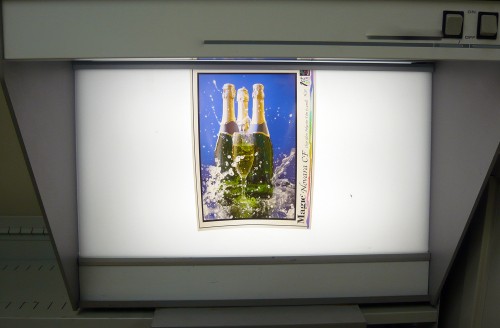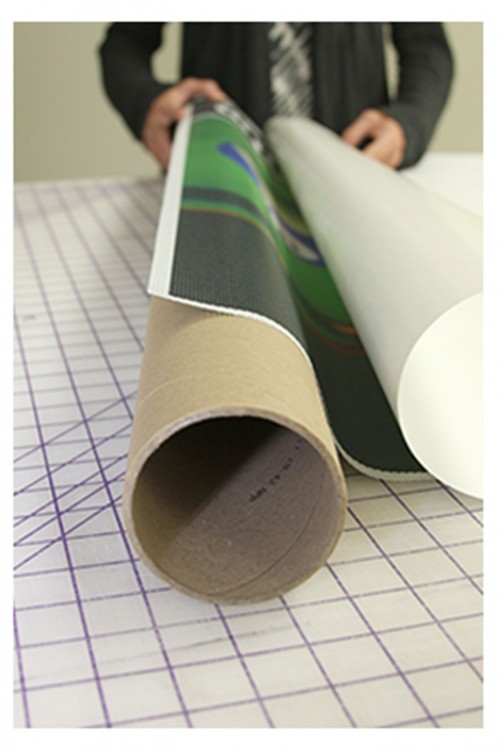Perforated films
Perforated window films are available today for both outside- and inside-surface-mounted graphics and are well-suited for solvent, eco-solvent and latex inkjet printing systems. They help prevent window graphic advertisements from completely blocking light and sightlines.
When selecting perforated window films, one of the keys is to look for the ideal ‘solid to hole’ ratio. For retail window graphics, in general, a 60-40 perforation ratio is ideal, as it will let people inside a store see through to what is happening outside, while people outside the building will only see a solid, vivid image.
Clear liquid laminates are compatible with perforated window films and will provide excellent surface protection. When applying them, the temperature of the film surface should be above 4 C (40 F).
With recent technological advances, some perforated films are now specifically designed to be printed on the adhesive side. To accomplish this, they combine an adhesive with an ink-receptive coating.
One advantage of this innovative design is it eliminates the need to laminate for protection, as window graphics can be mounted on the inner surface of a store window, where they are visible to the outdoors without risk of damage from the elements or vandalism.
Another advantage is graphics can easily be mounted on windows above ground level by someone inside the building, rather than needing a professional installer in a lift truck outside.
These materials require no additional adhesives or mounting tapes and, again, a 60-40 perforation ratio is ideal. To prevent any debris from settling on the printed side of these tacky window films, however, it is important to clean both the printer and the printing area prior to use, as well as place a clean silicone liner on the floor under the printer. Signmakers should unwind a few ‘wraps’ of the material to feed into the printer and then keep it draped on the unwinding roll, without the use of a take-up reel.
As with other media options, these inside-surface-mounted window graphics should be applied to a clean, dry glass surface at a temperature of 4 C (40 F) or higher. As the graphic is held up toward the glass, only the top edge should be tacked down at first. Then the rest of the application surface can be touched as the film is gently tacked, working downward and outward, using a soft squeegee or roller or by hand.
When installing a perforated-film window graphic, the film should first be peeled and folded back from about 25 mm (1 in.) of the liner. Once the film is aligned properly along the window, the top edge should be tacked down. From there, the remaining liner can be gently peeled away and the graphic applied evenly by hand, roller or smooth squeegee. The graphic can also be repositioned later.
Repositionable polypropylene
Repositionable PP films with low-tack adhesion are already popular for custom posters, short-term residential graphics and some retail displays, but they are now being increasingly used for both short- and long-term promotional window graphics, as well. PP is sufficiently durable for multiple uses and, unlike vinyl, will neither shrink with heat nor suffer any edge curling.
PP is a well-priced option for maximizing the production of lower-cost indoor and outdoor signage. Many substrate manufacturers offer it with a universal coating, allowing it to be printed across all platforms. By enhancing production flexibility, this allows sign shops to reduce their inventories of multiple substrates.
Once a PP window graphic is unrolled, it should be allowed to flatten at a minimum air and surface temperature of 10 C (50 F), after which it can simply be peeled back from its liner and applied in the desired location. The graphic should be squeegeed with minimal pressure while the liner is removed, smoothing out any wrinkles and bubbles as the film is applied to the glass.
PP window graphics can be reapplied after removing them slowly, lifting at a 90-degree angle. They can also be applied to other smooth, flat, clean surfaces besides glass.
A new generation
As seen in these and other examples, recent advances in technology have opened the door to a new generation of printable media options for highly appealing window graphics. Today’s signmakers can more easily produce high-end images with a softer appearance, using more environmentally friendly materials than before.
Jennifer Chagnon is director of digital imaging for Expopack Advanced Coatings, which develops, manufactures and distributes coated papers, films and specialty substrates under the Magic brand for inkjet printing. For more information, visit www.magicinkjet.com.







